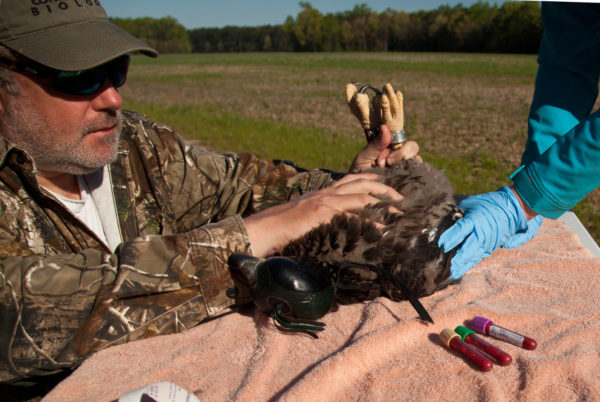Clean blood for eaglets within lower Chesapeake Bay

CCB collaborates on study of winter ecology of Ipswich sparrows
October 3, 2018
Moving Woodpeckers 4
January 15, 2019By Bryan Watts | bdwatt@wm.edu | (757) 221-2247
January 14, 2019
Between 2016 and 2018 CCB in partnership with the National Park Service collected blood samples from 25 eagle broods distributed throughout the lower Chesapeake Bay to measure their exposure to environmental contaminants. Exposure to key contaminants during the 1940s and 1950s is believed to have caused the population crash in the Bay and by the early 1970s levels in addled eggs were some of the highest recorded throughout North America. The recent effort was a periodic “checkup” to monitor exposure for breeding pairs under the care of the park service.

Blood samples were analyzed for a range of contaminant classes including heavy metals (cadmium, lead, mercury), polychrlorinated biphenyls (PCBs – 91 congeners) and organochrlorine pesticides (OCPs – 11 compounds). Blood concentrations of heavy metals were generally low and varied between metals examined. Cadmium did not exceed the level-of-detection for any sample. Detection frequencies for Lead and Mercury were 86 and 100% respectively. Lead concentrations were low and no sample exceeded the level believed to represent background for raptors. Blood concentrations of mercury were toward the lower to middle range of values reported from other studies of nestlings. Broods reared around lakes or tidal-fresh reaches of tributaries had higher concentrations of mercury than broods reared around high-saline waters. This is consistent with studies of eagle nestlings elsewhere within the breeding range. No samples approached the general threshold believed to result in possible reproductive impacts. Total PCB concentrations estimated during this study were on the low end of values reported from other regions. A cluster of the highest values were found within the lower James River. However, the highest values represented approximately 10% of the threshold suggested for reproductive impairment and 50% of the threshold suggested for no-observed-adverse-effect-level. Total OCP concentrations were lower than those reported from most other populations. p,p’-DDE was the most widespread pesticide compound and accounted for 93% of the total OCP values. Concentrations of p,p’-DDE were all below the level suggested for reproductive impairment and below the no-observed-adverse-effect-level for productivity.

Due to the endless parade of possible man-made products that may one day find their way into the Chesapeake Bay, vigilance for contaminants will always be a key component of management moving forward. However, the results of the blood tests conducted over the past three years are good news for the bald eagle population and for the improving health of the Chesapeake Bay.





